Effective Business Communication: Theory, Barriers, Solutions
VerifiedAdded on 2023/06/12
|12
|2355
|106
Report
AI Summary
This report provides an analysis of business communication, focusing on various theories such as directional theory, bureaucratic management theory, and scientific theory, while also differentiating between formal and informal communication. It identifies and discusses common barriers to effective communication, including physical, emotional, organizational, perceptual, and interpersonal barriers, detailing their negative impacts on organizational efficiency and employee morale. The report concludes by offering practical recommendations to overcome these barriers, such as flexible work arrangements, training and development sessions, technology maintenance, and strategies for fostering mutual respect and understanding among team members, ultimately emphasizing the importance of effective communication for enhanced decision-making and a positive organizational culture. Desklib is a platform where you can find this assignment and other study tools.
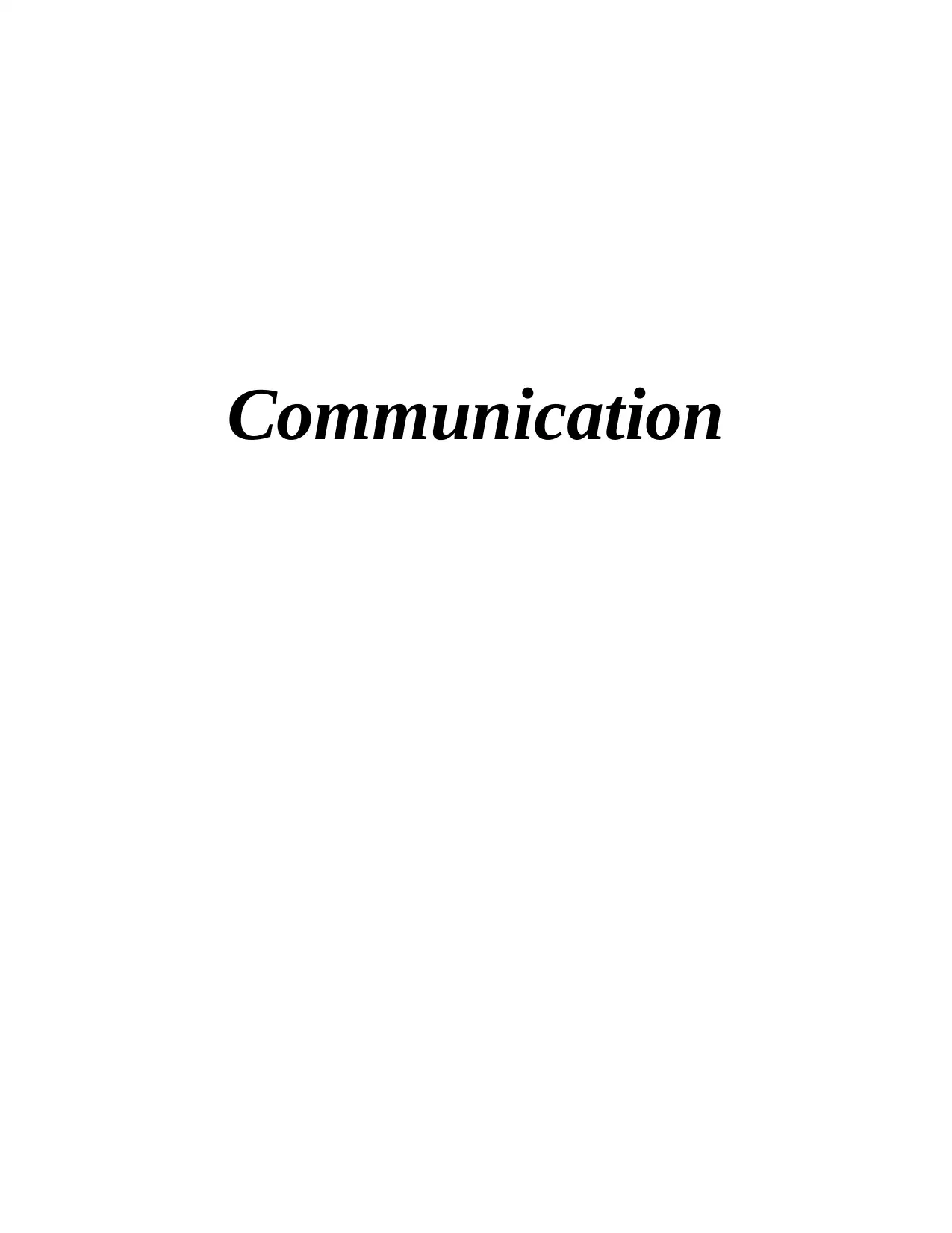
Communication
Paraphrase This Document
Need a fresh take? Get an instant paraphrase of this document with our AI Paraphraser
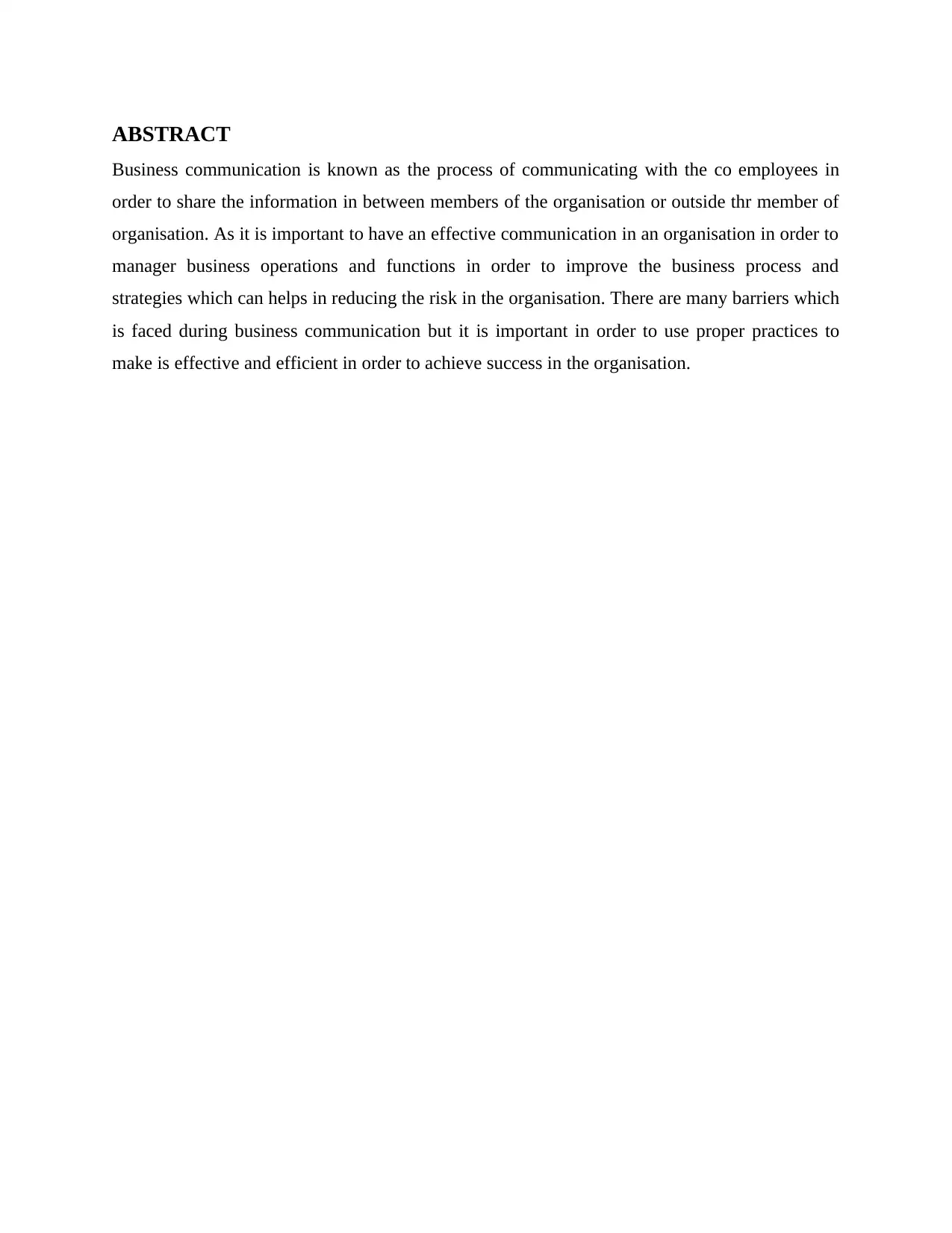
ABSTRACT
Business communication is known as the process of communicating with the co employees in
order to share the information in between members of the organisation or outside thr member of
organisation. As it is important to have an effective communication in an organisation in order to
manager business operations and functions in order to improve the business process and
strategies which can helps in reducing the risk in the organisation. There are many barriers which
is faced during business communication but it is important in order to use proper practices to
make is effective and efficient in order to achieve success in the organisation.
Business communication is known as the process of communicating with the co employees in
order to share the information in between members of the organisation or outside thr member of
organisation. As it is important to have an effective communication in an organisation in order to
manager business operations and functions in order to improve the business process and
strategies which can helps in reducing the risk in the organisation. There are many barriers which
is faced during business communication but it is important in order to use proper practices to
make is effective and efficient in order to achieve success in the organisation.
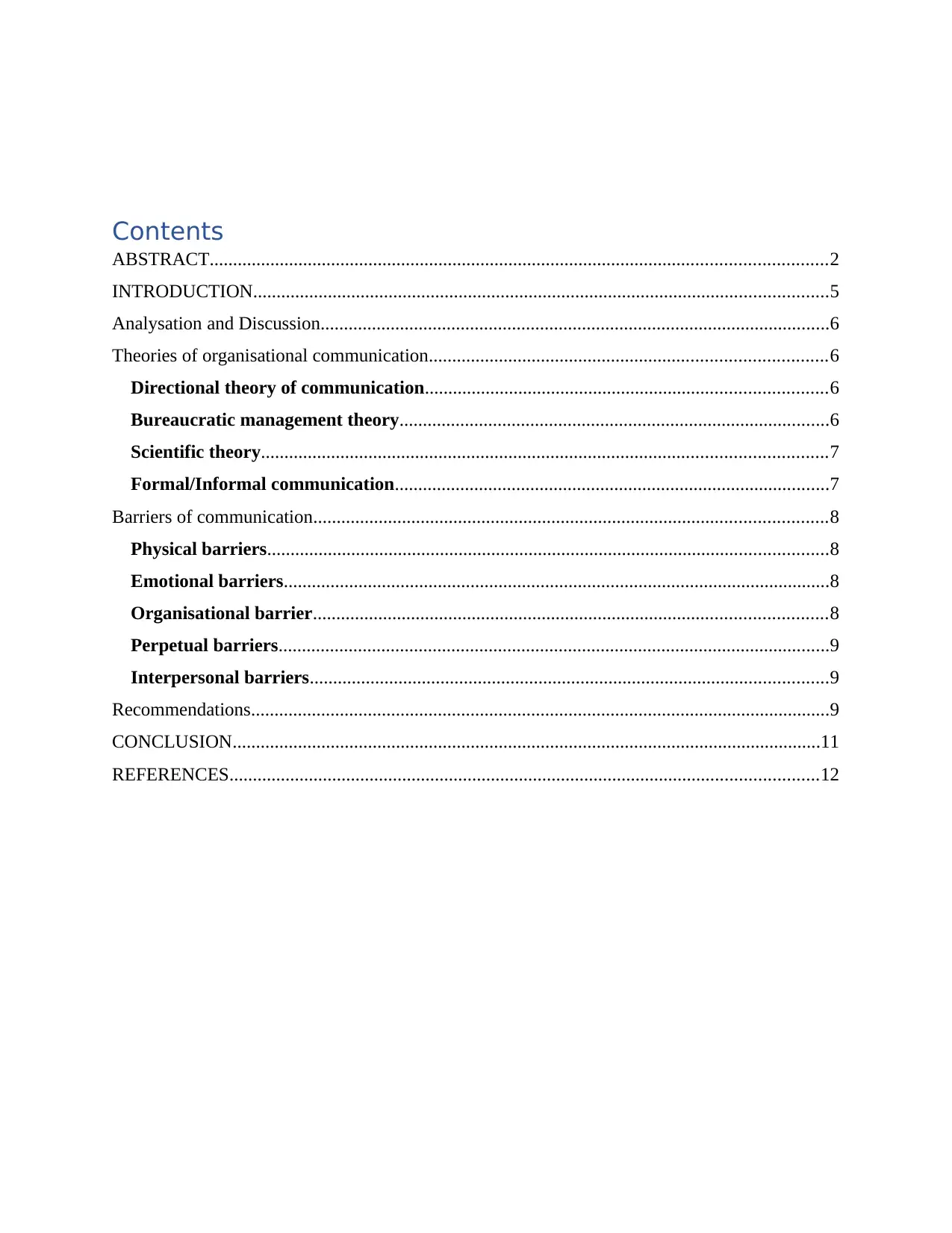
Contents
ABSTRACT....................................................................................................................................2
INTRODUCTION...........................................................................................................................5
Analysation and Discussion.............................................................................................................6
Theories of organisational communication.....................................................................................6
Directional theory of communication......................................................................................6
Bureaucratic management theory............................................................................................6
Scientific theory.........................................................................................................................7
Formal/Informal communication.............................................................................................7
Barriers of communication..............................................................................................................8
Physical barriers........................................................................................................................8
Emotional barriers.....................................................................................................................8
Organisational barrier..............................................................................................................8
Perpetual barriers......................................................................................................................9
Interpersonal barriers...............................................................................................................9
Recommendations............................................................................................................................9
CONCLUSION..............................................................................................................................11
REFERENCES..............................................................................................................................12
ABSTRACT....................................................................................................................................2
INTRODUCTION...........................................................................................................................5
Analysation and Discussion.............................................................................................................6
Theories of organisational communication.....................................................................................6
Directional theory of communication......................................................................................6
Bureaucratic management theory............................................................................................6
Scientific theory.........................................................................................................................7
Formal/Informal communication.............................................................................................7
Barriers of communication..............................................................................................................8
Physical barriers........................................................................................................................8
Emotional barriers.....................................................................................................................8
Organisational barrier..............................................................................................................8
Perpetual barriers......................................................................................................................9
Interpersonal barriers...............................................................................................................9
Recommendations............................................................................................................................9
CONCLUSION..............................................................................................................................11
REFERENCES..............................................................................................................................12
⊘ This is a preview!⊘
Do you want full access?
Subscribe today to unlock all pages.

Trusted by 1+ million students worldwide

Paraphrase This Document
Need a fresh take? Get an instant paraphrase of this document with our AI Paraphraser
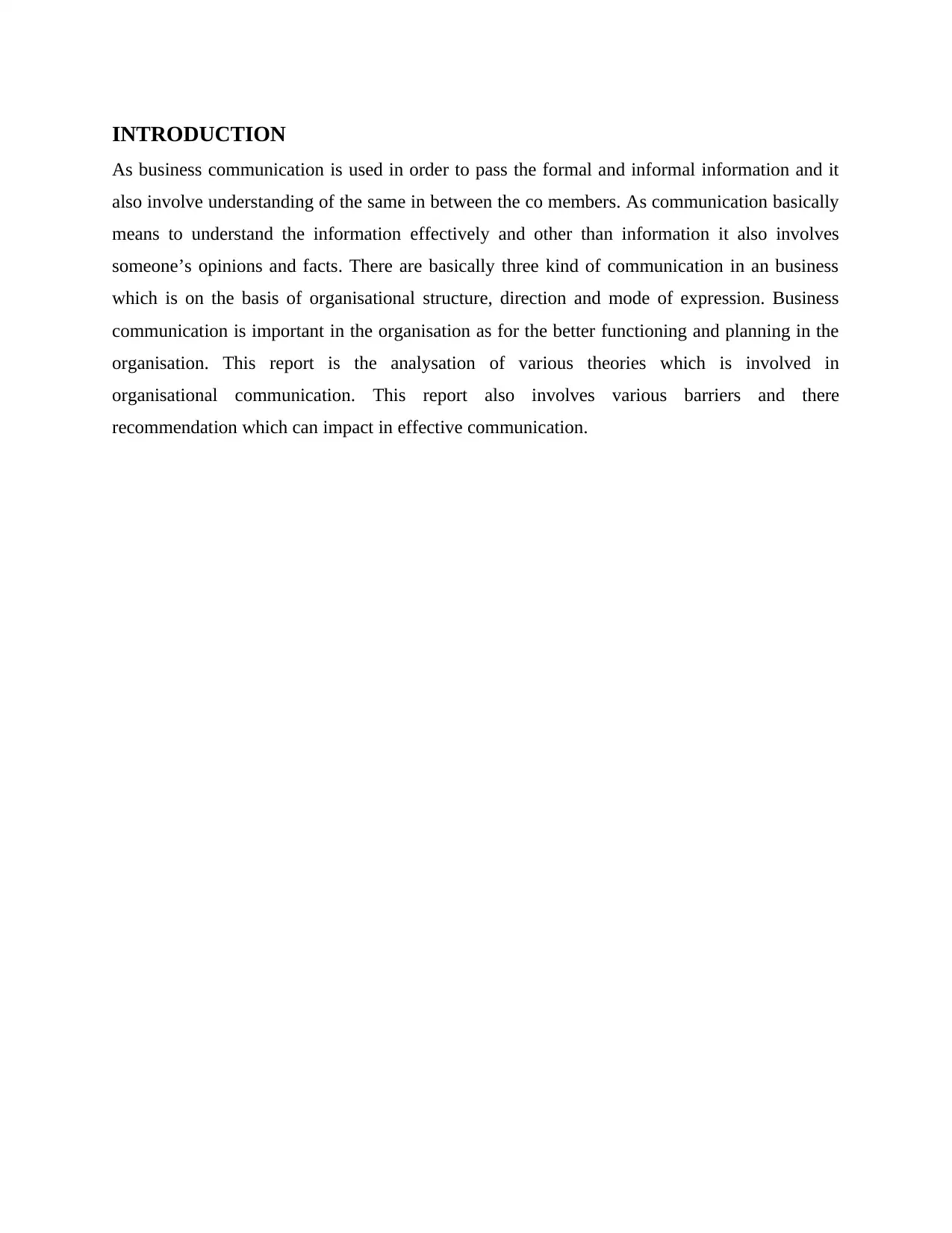
INTRODUCTION
As business communication is used in order to pass the formal and informal information and it
also involve understanding of the same in between the co members. As communication basically
means to understand the information effectively and other than information it also involves
someone’s opinions and facts. There are basically three kind of communication in an business
which is on the basis of organisational structure, direction and mode of expression. Business
communication is important in the organisation as for the better functioning and planning in the
organisation. This report is the analysation of various theories which is involved in
organisational communication. This report also involves various barriers and there
recommendation which can impact in effective communication.
As business communication is used in order to pass the formal and informal information and it
also involve understanding of the same in between the co members. As communication basically
means to understand the information effectively and other than information it also involves
someone’s opinions and facts. There are basically three kind of communication in an business
which is on the basis of organisational structure, direction and mode of expression. Business
communication is important in the organisation as for the better functioning and planning in the
organisation. This report is the analysation of various theories which is involved in
organisational communication. This report also involves various barriers and there
recommendation which can impact in effective communication.
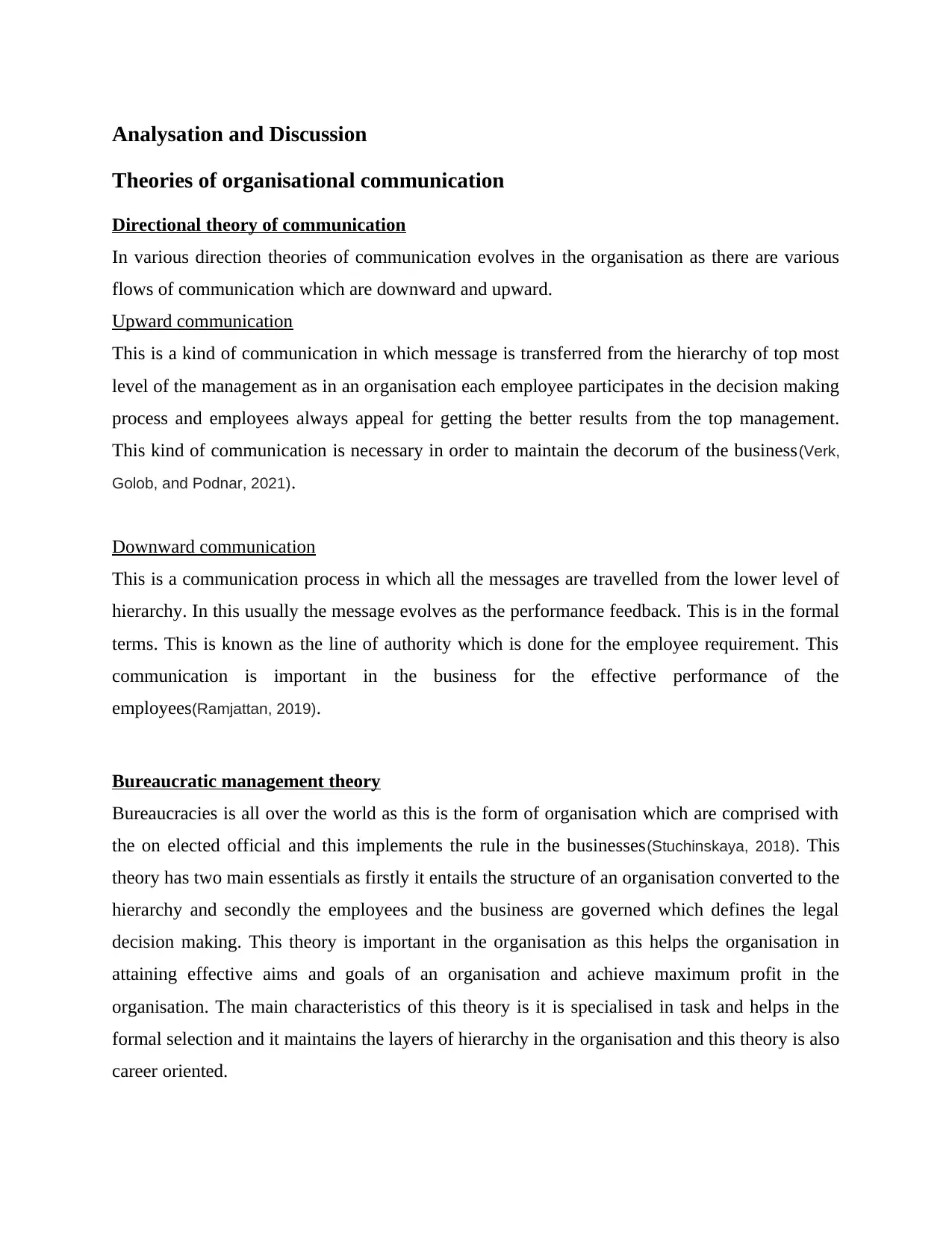
Analysation and Discussion
Theories of organisational communication
Directional theory of communication
In various direction theories of communication evolves in the organisation as there are various
flows of communication which are downward and upward.
Upward communication
This is a kind of communication in which message is transferred from the hierarchy of top most
level of the management as in an organisation each employee participates in the decision making
process and employees always appeal for getting the better results from the top management.
This kind of communication is necessary in order to maintain the decorum of the business(Verk,
Golob, and Podnar, 2021).
Downward communication
This is a communication process in which all the messages are travelled from the lower level of
hierarchy. In this usually the message evolves as the performance feedback. This is in the formal
terms. This is known as the line of authority which is done for the employee requirement. This
communication is important in the business for the effective performance of the
employees(Ramjattan, 2019).
Bureaucratic management theory
Bureaucracies is all over the world as this is the form of organisation which are comprised with
the on elected official and this implements the rule in the businesses(Stuchinskaya, 2018). This
theory has two main essentials as firstly it entails the structure of an organisation converted to the
hierarchy and secondly the employees and the business are governed which defines the legal
decision making. This theory is important in the organisation as this helps the organisation in
attaining effective aims and goals of an organisation and achieve maximum profit in the
organisation. The main characteristics of this theory is it is specialised in task and helps in the
formal selection and it maintains the layers of hierarchy in the organisation and this theory is also
career oriented.
Theories of organisational communication
Directional theory of communication
In various direction theories of communication evolves in the organisation as there are various
flows of communication which are downward and upward.
Upward communication
This is a kind of communication in which message is transferred from the hierarchy of top most
level of the management as in an organisation each employee participates in the decision making
process and employees always appeal for getting the better results from the top management.
This kind of communication is necessary in order to maintain the decorum of the business(Verk,
Golob, and Podnar, 2021).
Downward communication
This is a communication process in which all the messages are travelled from the lower level of
hierarchy. In this usually the message evolves as the performance feedback. This is in the formal
terms. This is known as the line of authority which is done for the employee requirement. This
communication is important in the business for the effective performance of the
employees(Ramjattan, 2019).
Bureaucratic management theory
Bureaucracies is all over the world as this is the form of organisation which are comprised with
the on elected official and this implements the rule in the businesses(Stuchinskaya, 2018). This
theory has two main essentials as firstly it entails the structure of an organisation converted to the
hierarchy and secondly the employees and the business are governed which defines the legal
decision making. This theory is important in the organisation as this helps the organisation in
attaining effective aims and goals of an organisation and achieve maximum profit in the
organisation. The main characteristics of this theory is it is specialised in task and helps in the
formal selection and it maintains the layers of hierarchy in the organisation and this theory is also
career oriented.
⊘ This is a preview!⊘
Do you want full access?
Subscribe today to unlock all pages.

Trusted by 1+ million students worldwide
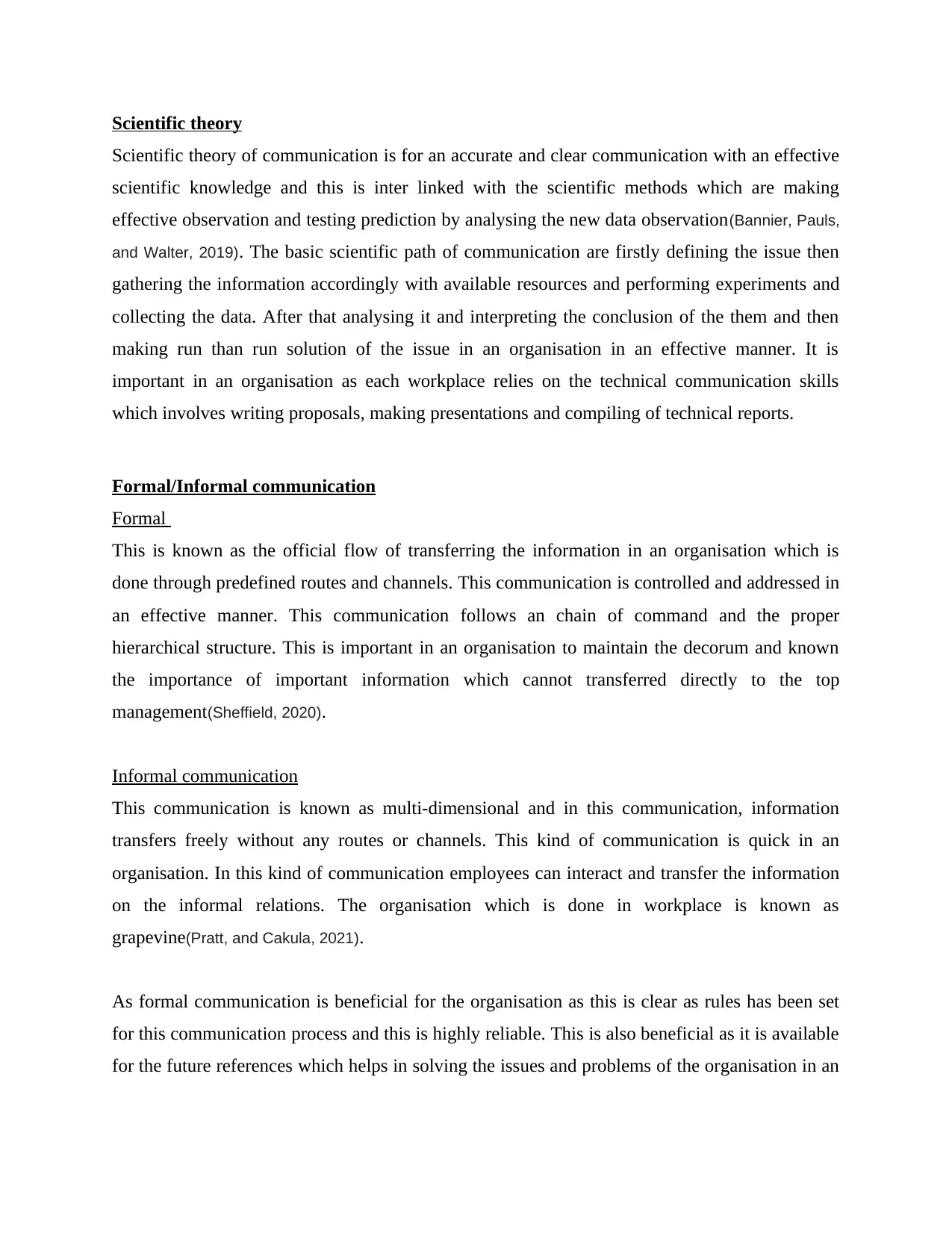
Scientific theory
Scientific theory of communication is for an accurate and clear communication with an effective
scientific knowledge and this is inter linked with the scientific methods which are making
effective observation and testing prediction by analysing the new data observation(Bannier, Pauls,
and Walter, 2019). The basic scientific path of communication are firstly defining the issue then
gathering the information accordingly with available resources and performing experiments and
collecting the data. After that analysing it and interpreting the conclusion of the them and then
making run than run solution of the issue in an organisation in an effective manner. It is
important in an organisation as each workplace relies on the technical communication skills
which involves writing proposals, making presentations and compiling of technical reports.
Formal/Informal communication
Formal
This is known as the official flow of transferring the information in an organisation which is
done through predefined routes and channels. This communication is controlled and addressed in
an effective manner. This communication follows an chain of command and the proper
hierarchical structure. This is important in an organisation to maintain the decorum and known
the importance of important information which cannot transferred directly to the top
management(Sheffield, 2020).
Informal communication
This communication is known as multi-dimensional and in this communication, information
transfers freely without any routes or channels. This kind of communication is quick in an
organisation. In this kind of communication employees can interact and transfer the information
on the informal relations. The organisation which is done in workplace is known as
grapevine(Pratt, and Cakula, 2021).
As formal communication is beneficial for the organisation as this is clear as rules has been set
for this communication process and this is highly reliable. This is also beneficial as it is available
for the future references which helps in solving the issues and problems of the organisation in an
Scientific theory of communication is for an accurate and clear communication with an effective
scientific knowledge and this is inter linked with the scientific methods which are making
effective observation and testing prediction by analysing the new data observation(Bannier, Pauls,
and Walter, 2019). The basic scientific path of communication are firstly defining the issue then
gathering the information accordingly with available resources and performing experiments and
collecting the data. After that analysing it and interpreting the conclusion of the them and then
making run than run solution of the issue in an organisation in an effective manner. It is
important in an organisation as each workplace relies on the technical communication skills
which involves writing proposals, making presentations and compiling of technical reports.
Formal/Informal communication
Formal
This is known as the official flow of transferring the information in an organisation which is
done through predefined routes and channels. This communication is controlled and addressed in
an effective manner. This communication follows an chain of command and the proper
hierarchical structure. This is important in an organisation to maintain the decorum and known
the importance of important information which cannot transferred directly to the top
management(Sheffield, 2020).
Informal communication
This communication is known as multi-dimensional and in this communication, information
transfers freely without any routes or channels. This kind of communication is quick in an
organisation. In this kind of communication employees can interact and transfer the information
on the informal relations. The organisation which is done in workplace is known as
grapevine(Pratt, and Cakula, 2021).
As formal communication is beneficial for the organisation as this is clear as rules has been set
for this communication process and this is highly reliable. This is also beneficial as it is available
for the future references which helps in solving the issues and problems of the organisation in an
Paraphrase This Document
Need a fresh take? Get an instant paraphrase of this document with our AI Paraphraser
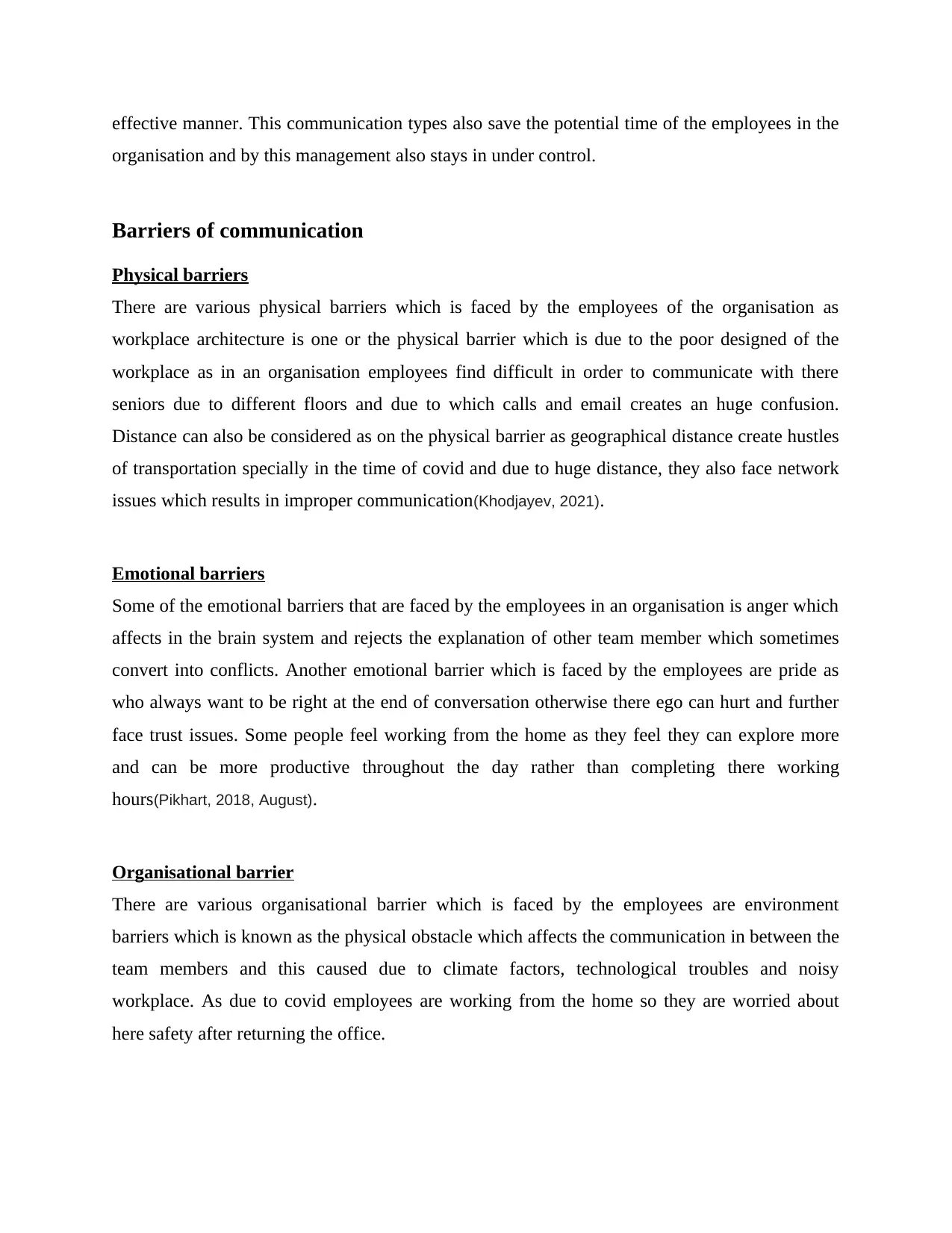
effective manner. This communication types also save the potential time of the employees in the
organisation and by this management also stays in under control.
Barriers of communication
Physical barriers
There are various physical barriers which is faced by the employees of the organisation as
workplace architecture is one or the physical barrier which is due to the poor designed of the
workplace as in an organisation employees find difficult in order to communicate with there
seniors due to different floors and due to which calls and email creates an huge confusion.
Distance can also be considered as on the physical barrier as geographical distance create hustles
of transportation specially in the time of covid and due to huge distance, they also face network
issues which results in improper communication(Khodjayev, 2021).
Emotional barriers
Some of the emotional barriers that are faced by the employees in an organisation is anger which
affects in the brain system and rejects the explanation of other team member which sometimes
convert into conflicts. Another emotional barrier which is faced by the employees are pride as
who always want to be right at the end of conversation otherwise there ego can hurt and further
face trust issues. Some people feel working from the home as they feel they can explore more
and can be more productive throughout the day rather than completing there working
hours(Pikhart, 2018, August).
Organisational barrier
There are various organisational barrier which is faced by the employees are environment
barriers which is known as the physical obstacle which affects the communication in between the
team members and this caused due to climate factors, technological troubles and noisy
workplace. As due to covid employees are working from the home so they are worried about
here safety after returning the office.
organisation and by this management also stays in under control.
Barriers of communication
Physical barriers
There are various physical barriers which is faced by the employees of the organisation as
workplace architecture is one or the physical barrier which is due to the poor designed of the
workplace as in an organisation employees find difficult in order to communicate with there
seniors due to different floors and due to which calls and email creates an huge confusion.
Distance can also be considered as on the physical barrier as geographical distance create hustles
of transportation specially in the time of covid and due to huge distance, they also face network
issues which results in improper communication(Khodjayev, 2021).
Emotional barriers
Some of the emotional barriers that are faced by the employees in an organisation is anger which
affects in the brain system and rejects the explanation of other team member which sometimes
convert into conflicts. Another emotional barrier which is faced by the employees are pride as
who always want to be right at the end of conversation otherwise there ego can hurt and further
face trust issues. Some people feel working from the home as they feel they can explore more
and can be more productive throughout the day rather than completing there working
hours(Pikhart, 2018, August).
Organisational barrier
There are various organisational barrier which is faced by the employees are environment
barriers which is known as the physical obstacle which affects the communication in between the
team members and this caused due to climate factors, technological troubles and noisy
workplace. As due to covid employees are working from the home so they are worried about
here safety after returning the office.
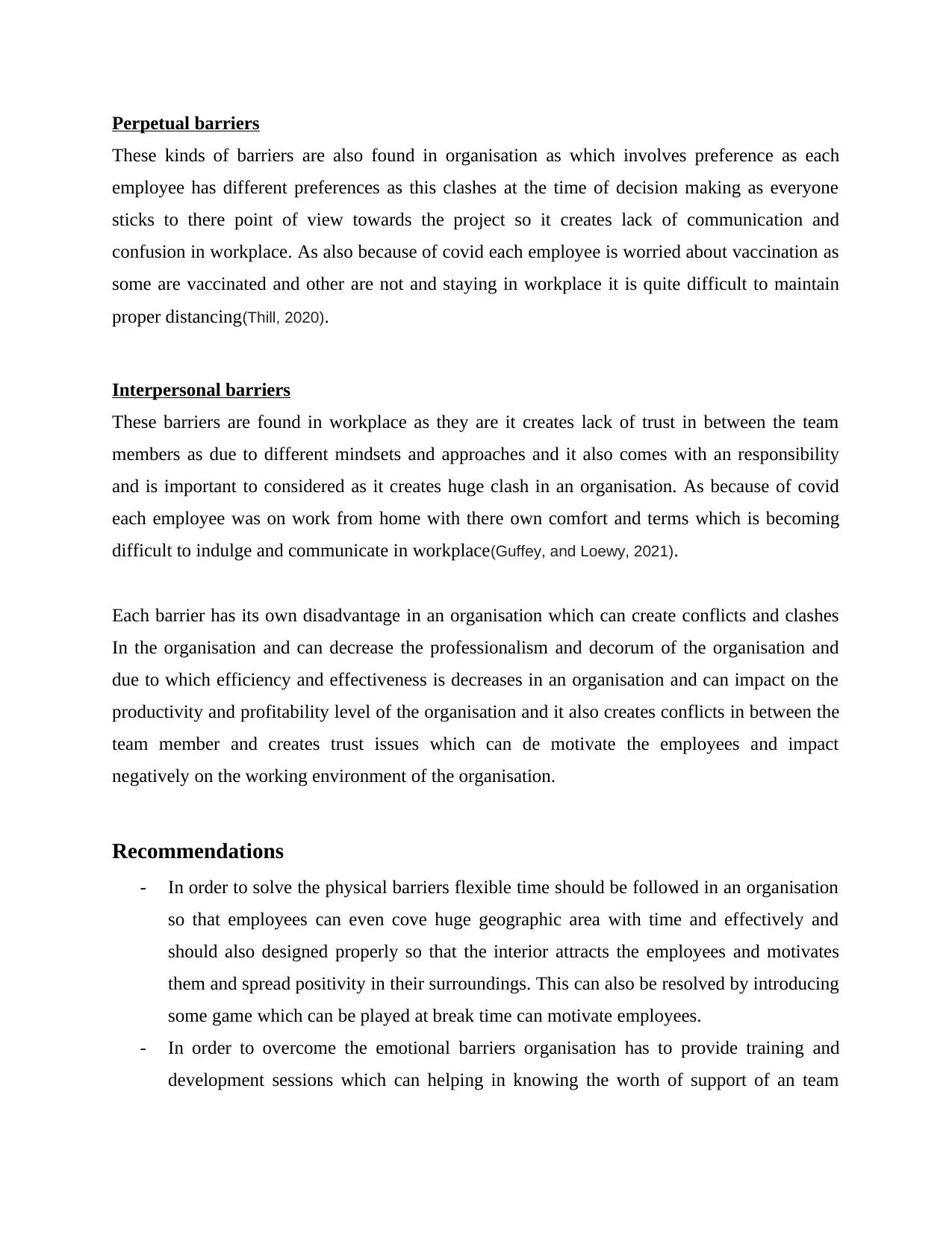
Perpetual barriers
These kinds of barriers are also found in organisation as which involves preference as each
employee has different preferences as this clashes at the time of decision making as everyone
sticks to there point of view towards the project so it creates lack of communication and
confusion in workplace. As also because of covid each employee is worried about vaccination as
some are vaccinated and other are not and staying in workplace it is quite difficult to maintain
proper distancing(Thill, 2020).
Interpersonal barriers
These barriers are found in workplace as they are it creates lack of trust in between the team
members as due to different mindsets and approaches and it also comes with an responsibility
and is important to considered as it creates huge clash in an organisation. As because of covid
each employee was on work from home with there own comfort and terms which is becoming
difficult to indulge and communicate in workplace(Guffey, and Loewy, 2021).
Each barrier has its own disadvantage in an organisation which can create conflicts and clashes
In the organisation and can decrease the professionalism and decorum of the organisation and
due to which efficiency and effectiveness is decreases in an organisation and can impact on the
productivity and profitability level of the organisation and it also creates conflicts in between the
team member and creates trust issues which can de motivate the employees and impact
negatively on the working environment of the organisation.
Recommendations
- In order to solve the physical barriers flexible time should be followed in an organisation
so that employees can even cove huge geographic area with time and effectively and
should also designed properly so that the interior attracts the employees and motivates
them and spread positivity in their surroundings. This can also be resolved by introducing
some game which can be played at break time can motivate employees.
- In order to overcome the emotional barriers organisation has to provide training and
development sessions which can helping in knowing the worth of support of an team
These kinds of barriers are also found in organisation as which involves preference as each
employee has different preferences as this clashes at the time of decision making as everyone
sticks to there point of view towards the project so it creates lack of communication and
confusion in workplace. As also because of covid each employee is worried about vaccination as
some are vaccinated and other are not and staying in workplace it is quite difficult to maintain
proper distancing(Thill, 2020).
Interpersonal barriers
These barriers are found in workplace as they are it creates lack of trust in between the team
members as due to different mindsets and approaches and it also comes with an responsibility
and is important to considered as it creates huge clash in an organisation. As because of covid
each employee was on work from home with there own comfort and terms which is becoming
difficult to indulge and communicate in workplace(Guffey, and Loewy, 2021).
Each barrier has its own disadvantage in an organisation which can create conflicts and clashes
In the organisation and can decrease the professionalism and decorum of the organisation and
due to which efficiency and effectiveness is decreases in an organisation and can impact on the
productivity and profitability level of the organisation and it also creates conflicts in between the
team member and creates trust issues which can de motivate the employees and impact
negatively on the working environment of the organisation.
Recommendations
- In order to solve the physical barriers flexible time should be followed in an organisation
so that employees can even cove huge geographic area with time and effectively and
should also designed properly so that the interior attracts the employees and motivates
them and spread positivity in their surroundings. This can also be resolved by introducing
some game which can be played at break time can motivate employees.
- In order to overcome the emotional barriers organisation has to provide training and
development sessions which can helping in knowing the worth of support of an team
⊘ This is a preview!⊘
Do you want full access?
Subscribe today to unlock all pages.

Trusted by 1+ million students worldwide
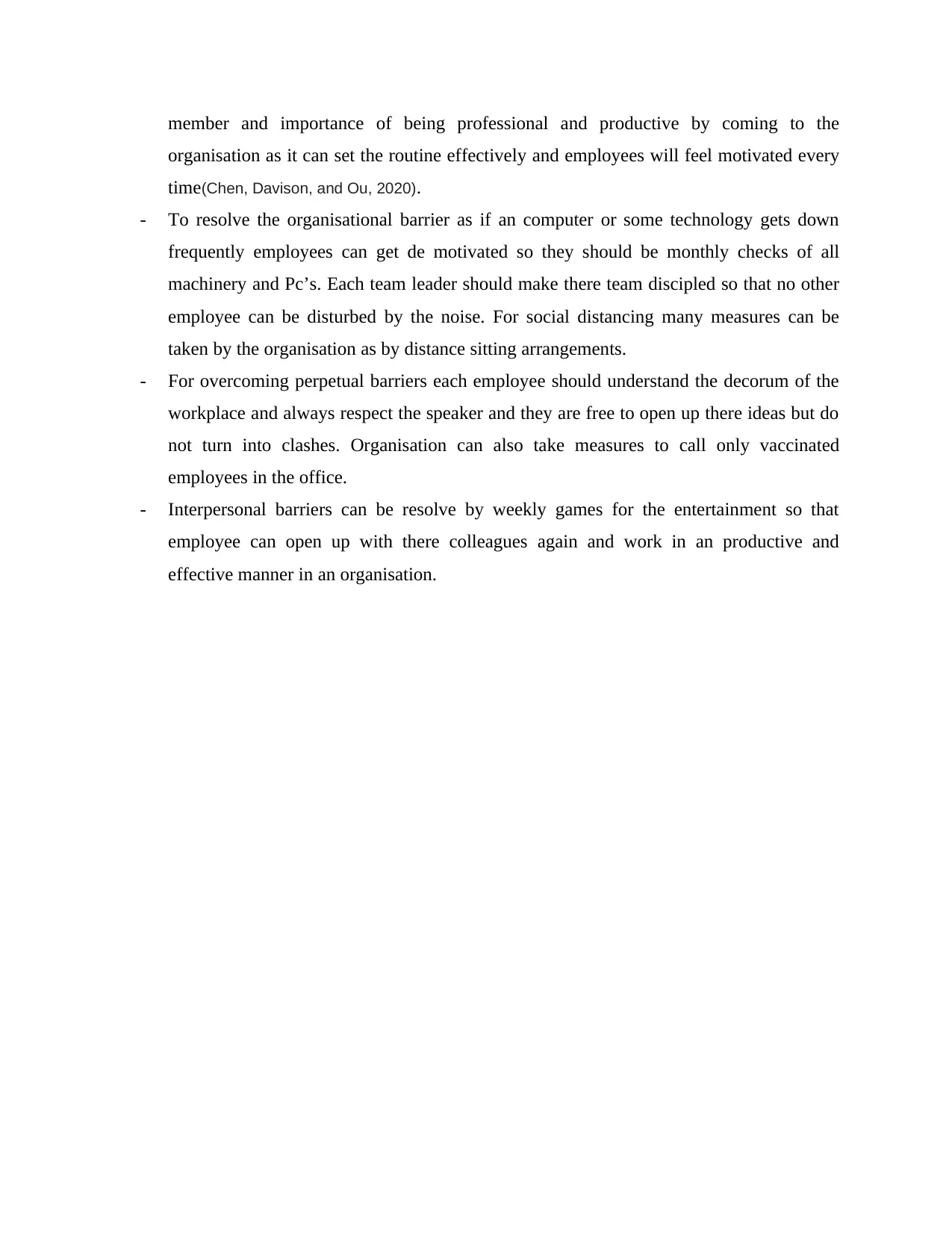
member and importance of being professional and productive by coming to the
organisation as it can set the routine effectively and employees will feel motivated every
time(Chen, Davison, and Ou, 2020).
- To resolve the organisational barrier as if an computer or some technology gets down
frequently employees can get de motivated so they should be monthly checks of all
machinery and Pc’s. Each team leader should make there team discipled so that no other
employee can be disturbed by the noise. For social distancing many measures can be
taken by the organisation as by distance sitting arrangements.
- For overcoming perpetual barriers each employee should understand the decorum of the
workplace and always respect the speaker and they are free to open up there ideas but do
not turn into clashes. Organisation can also take measures to call only vaccinated
employees in the office.
- Interpersonal barriers can be resolve by weekly games for the entertainment so that
employee can open up with there colleagues again and work in an productive and
effective manner in an organisation.
organisation as it can set the routine effectively and employees will feel motivated every
time(Chen, Davison, and Ou, 2020).
- To resolve the organisational barrier as if an computer or some technology gets down
frequently employees can get de motivated so they should be monthly checks of all
machinery and Pc’s. Each team leader should make there team discipled so that no other
employee can be disturbed by the noise. For social distancing many measures can be
taken by the organisation as by distance sitting arrangements.
- For overcoming perpetual barriers each employee should understand the decorum of the
workplace and always respect the speaker and they are free to open up there ideas but do
not turn into clashes. Organisation can also take measures to call only vaccinated
employees in the office.
- Interpersonal barriers can be resolve by weekly games for the entertainment so that
employee can open up with there colleagues again and work in an productive and
effective manner in an organisation.
Paraphrase This Document
Need a fresh take? Get an instant paraphrase of this document with our AI Paraphraser
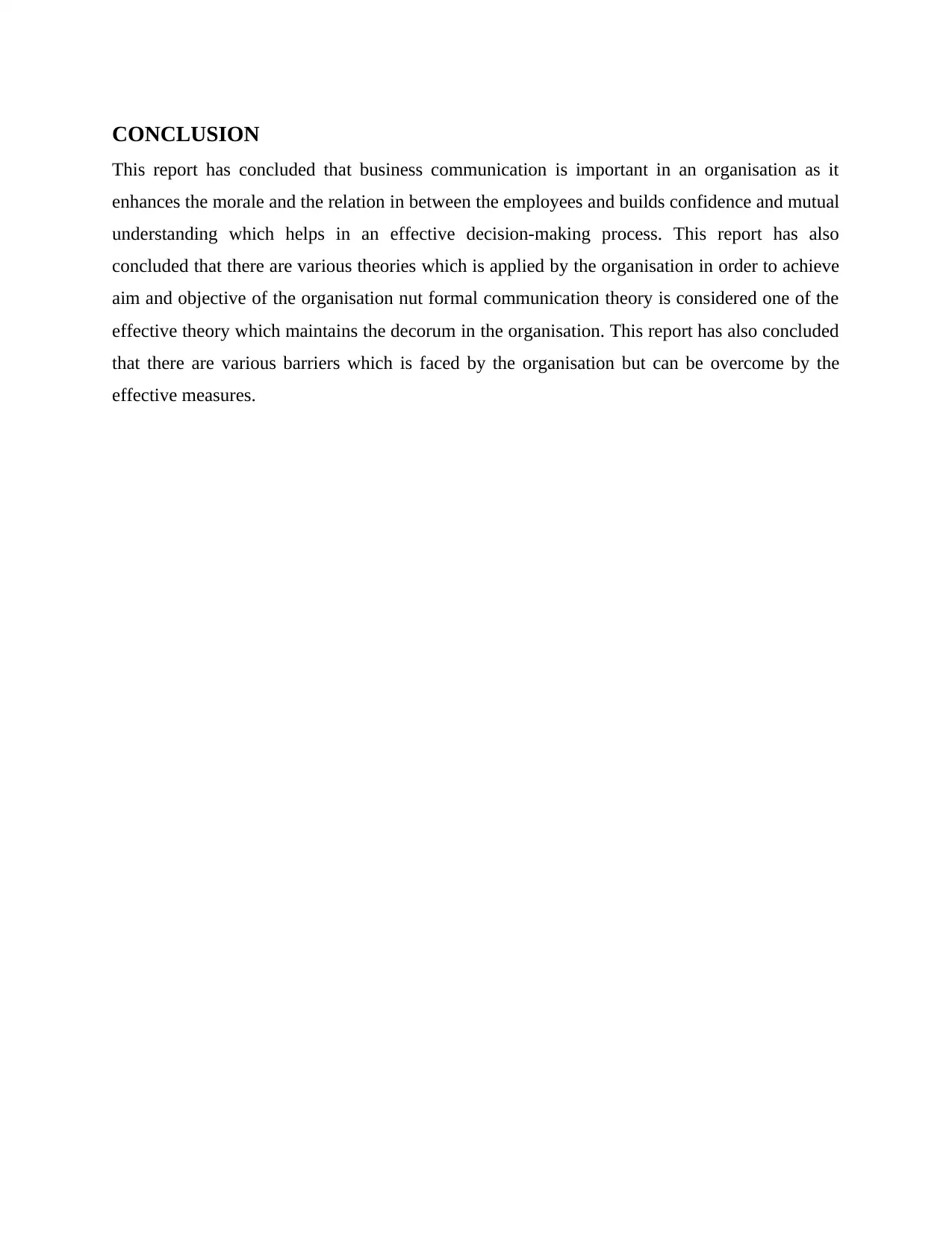
CONCLUSION
This report has concluded that business communication is important in an organisation as it
enhances the morale and the relation in between the employees and builds confidence and mutual
understanding which helps in an effective decision-making process. This report has also
concluded that there are various theories which is applied by the organisation in order to achieve
aim and objective of the organisation nut formal communication theory is considered one of the
effective theory which maintains the decorum in the organisation. This report has also concluded
that there are various barriers which is faced by the organisation but can be overcome by the
effective measures.
This report has concluded that business communication is important in an organisation as it
enhances the morale and the relation in between the employees and builds confidence and mutual
understanding which helps in an effective decision-making process. This report has also
concluded that there are various theories which is applied by the organisation in order to achieve
aim and objective of the organisation nut formal communication theory is considered one of the
effective theory which maintains the decorum in the organisation. This report has also concluded
that there are various barriers which is faced by the organisation but can be overcome by the
effective measures.
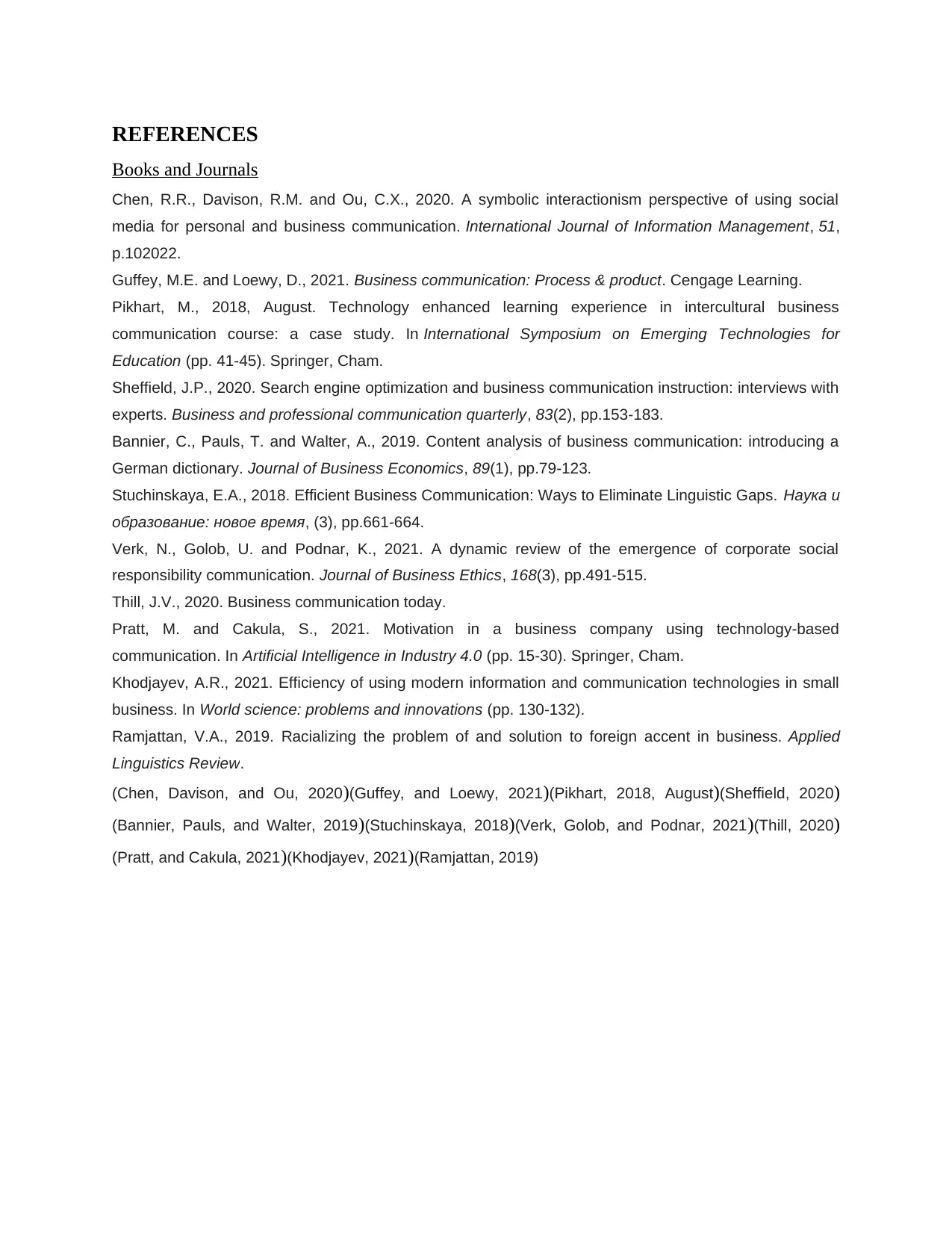
REFERENCES
Books and Journals
Chen, R.R., Davison, R.M. and Ou, C.X., 2020. A symbolic interactionism perspective of using social
media for personal and business communication. International Journal of Information Management, 51,
p.102022.
Guffey, M.E. and Loewy, D., 2021. Business communication: Process & product. Cengage Learning.
Pikhart, M., 2018, August. Technology enhanced learning experience in intercultural business
communication course: a case study. In International Symposium on Emerging Technologies for
Education (pp. 41-45). Springer, Cham.
Sheffield, J.P., 2020. Search engine optimization and business communication instruction: interviews with
experts. Business and professional communication quarterly, 83(2), pp.153-183.
Bannier, C., Pauls, T. and Walter, A., 2019. Content analysis of business communication: introducing a
German dictionary. Journal of Business Economics, 89(1), pp.79-123.
Stuchinskaya, E.A., 2018. Efficient Business Communication: Ways to Eliminate Linguistic Gaps. Наука и
образование: новое время, (3), pp.661-664.
Verk, N., Golob, U. and Podnar, K., 2021. A dynamic review of the emergence of corporate social
responsibility communication. Journal of Business Ethics, 168(3), pp.491-515.
Thill, J.V., 2020. Business communication today.
Pratt, M. and Cakula, S., 2021. Motivation in a business company using technology-based
communication. In Artificial Intelligence in Industry 4.0 (pp. 15-30). Springer, Cham.
Khodjayev, A.R., 2021. Efficiency of using modern information and communication technologies in small
business. In World science: problems and innovations (pp. 130-132).
Ramjattan, V.A., 2019. Racializing the problem of and solution to foreign accent in business. Applied
Linguistics Review.
(Chen, Davison, and Ou, 2020)(Guffey, and Loewy, 2021)(Pikhart, 2018, August)(Sheffield, 2020)
(Bannier, Pauls, and Walter, 2019)(Stuchinskaya, 2018)(Verk, Golob, and Podnar, 2021)(Thill, 2020)
(Pratt, and Cakula, 2021)(Khodjayev, 2021)(Ramjattan, 2019)
Books and Journals
Chen, R.R., Davison, R.M. and Ou, C.X., 2020. A symbolic interactionism perspective of using social
media for personal and business communication. International Journal of Information Management, 51,
p.102022.
Guffey, M.E. and Loewy, D., 2021. Business communication: Process & product. Cengage Learning.
Pikhart, M., 2018, August. Technology enhanced learning experience in intercultural business
communication course: a case study. In International Symposium on Emerging Technologies for
Education (pp. 41-45). Springer, Cham.
Sheffield, J.P., 2020. Search engine optimization and business communication instruction: interviews with
experts. Business and professional communication quarterly, 83(2), pp.153-183.
Bannier, C., Pauls, T. and Walter, A., 2019. Content analysis of business communication: introducing a
German dictionary. Journal of Business Economics, 89(1), pp.79-123.
Stuchinskaya, E.A., 2018. Efficient Business Communication: Ways to Eliminate Linguistic Gaps. Наука и
образование: новое время, (3), pp.661-664.
Verk, N., Golob, U. and Podnar, K., 2021. A dynamic review of the emergence of corporate social
responsibility communication. Journal of Business Ethics, 168(3), pp.491-515.
Thill, J.V., 2020. Business communication today.
Pratt, M. and Cakula, S., 2021. Motivation in a business company using technology-based
communication. In Artificial Intelligence in Industry 4.0 (pp. 15-30). Springer, Cham.
Khodjayev, A.R., 2021. Efficiency of using modern information and communication technologies in small
business. In World science: problems and innovations (pp. 130-132).
Ramjattan, V.A., 2019. Racializing the problem of and solution to foreign accent in business. Applied
Linguistics Review.
(Chen, Davison, and Ou, 2020)(Guffey, and Loewy, 2021)(Pikhart, 2018, August)(Sheffield, 2020)
(Bannier, Pauls, and Walter, 2019)(Stuchinskaya, 2018)(Verk, Golob, and Podnar, 2021)(Thill, 2020)
(Pratt, and Cakula, 2021)(Khodjayev, 2021)(Ramjattan, 2019)
⊘ This is a preview!⊘
Do you want full access?
Subscribe today to unlock all pages.

Trusted by 1+ million students worldwide
1 out of 12
Related Documents
Your All-in-One AI-Powered Toolkit for Academic Success.
+13062052269
info@desklib.com
Available 24*7 on WhatsApp / Email
![[object Object]](/_next/static/media/star-bottom.7253800d.svg)
Unlock your academic potential
Copyright © 2020–2025 A2Z Services. All Rights Reserved. Developed and managed by ZUCOL.





